Ornithogalum viridiflorum
Ornithogalum viridiflorum (I.Verd.) J.C.Manning & Goldblatt (= Galtonia viridiflora I.Verd.)
Family: Hyacinthaceae
Common names: green berg lily
Introduction
With its pale green foliage and upright stems crowned with yellowish green, bell-shaped, flowers, Green Berg Lilies make wonderful, ornamental garden plants and are worthy of a spot in any garden.
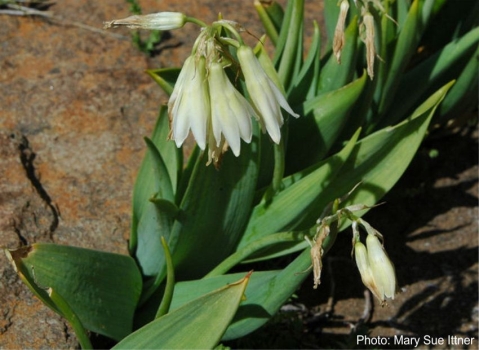
Description
Description
Ornithogalum viridiflorum is a perennial, summer-growing bulbous plant, that goes dormant from autumn through winter into spring. The bulb is tunicated, tapering into a thin neck and grows from 40 to 200 mm in diameter. The foliage is succulent and arranged in a rosette. There are about 7 leaves that are erect, pale yellowish-green with a greyish bloom, strap-shaped, with a broad base and a pointed tip (mucronate).
The pale green inflorescence appears in the middle of the leaves and grows up to 1 m tall. The inflorescence is a raceme made up of many bell-shaped, pendulous, yellowish-green flowers. The raceme ranges from 150 mm to 300 mm long. The bracts are greenish, becoming thin, up to 30 mm long and 5 mm broad at the base. Pale green pedicels differ in length, they can grow up to 25 mm long. The perianth is pale green, drooping, about 25 mm long, the floral tube is about 9 mm long, lobes are about 15 mm long and 6-7 mm broad on the outer part. The filament is white, up to 8 mm long, the anthers are dark green and up to 3 mm long when mature. The ovary is green, 6 mm long. The seeds are brown, rounded on the third face, the top and the bottom are flattened, 7 x 4.5 x 2 mm.
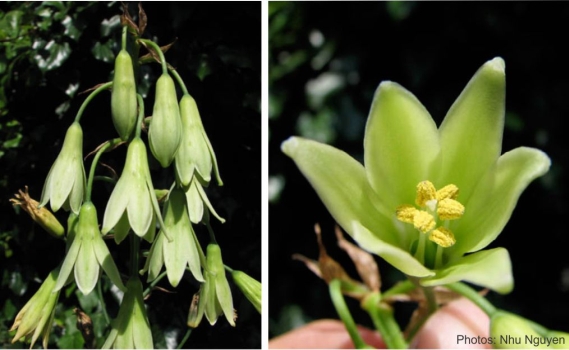
Conservation Status
Status
According to Red List of South African Plants, Ornithogalum viridiflorum is regarded as being of Least Concern (LC). It is not threatened or declining in its natural habitat.
Distribution and habitat
Distribution description
The distribution of Ornithogalum viridiflorum extends from the Free State Witteberg via Lesotho’s highlands to the Witteberg of the northern Eastern Cape. This species favours dry areas, it is found on dry cliffs, steep rocky slopes, rubbly slopes and drier places above the Escarpment mostly in Lesotho.
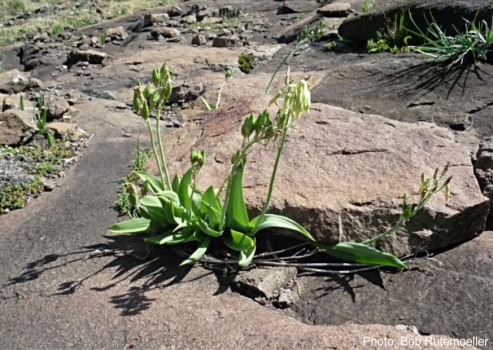
Derivation of name and historical aspects
History
The genus name Ornithogalum is derived from Greek, where ornitho means ‘bird’s’ and gala means ‘milk’, for the Greeks, birds milk was an informal declaration of something wonderful. The flowers of some plants have milky white sap, hence some authors proposed that the name refers to that. The species name viridiflorum is derived from Latin, where viridis means ‘fresh green’ and florum means ‘flower’.
The late Mrs. Boddam-Whetham was the first to make the National Herbarium staff take notice of Ornithogalum viridiflorum, when, in 1947, Mrs Jacot Guillarmod sent a specimen to the herbarium from Lesotho. It was found that Mr O’Connor from Durban Deep, West Rand was growing this species in his garden in 1954, he collected the seeds 14 years before in the mountain where there habitat is rocky and had lava beds overlying cave sandstone in the mountains near the Natal National Park. Several specimens already in the herbarium were discovered to be Ornithogalum viridiflorum, including one that Dr. F. Z. van der Merwe.
Ecology
Ecology
The Green Berg Lily has deciduous leaves, it grows during summer, the leaves die back in autumn and the underground bulb is dormant during winter, which allows it to survive the harsh, cold winter months.
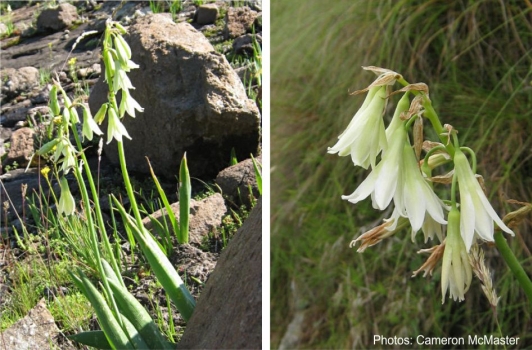
Uses
Use
The Green Berg Lily is suitable for a bulb garden, rock garden, grassland garden or a sunny mixed border. It also does well in areas which experience bad frost as it it frost hardy.
Green berg lilies make wonderful cut flowers since they are extremely ornamental and have long-lasting blooms, thus they deserve to be grown more widely. The plants flower for about 2 months, which makes this species a good contender for the cut flower industry.
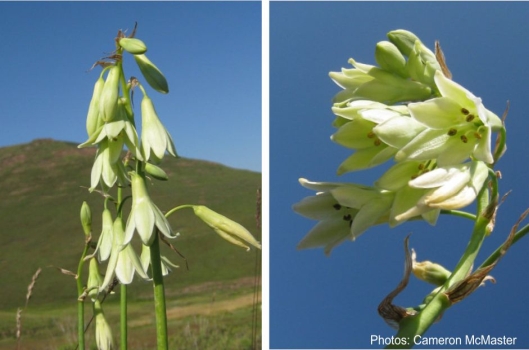
Growing Ornithogalum viridiflorum
Grow
The Green Berg Lily does well in both semi-shade and full sun. They prefer a rich soil with good drainage. Plant the bulbs shallowly, about 2 cm deep, and leave them undisturbed for 2-3 years.
This lily can be multiplied by offsets or seeds. Remove the offsets during the dormant season (winter), but this method is rather very slow for mass production. Propagation by seed is recommended for mass propagation. Sow seeds in spring, they are easy to germinate. Plant out young bulbs in the garden after their second or third year, they usually flower for the first time around this time.
This species is rarely infested by pests but be mindful of snails, they can cause significant damage to the leaves if left uncontrolled.
References
- Du PLessis, N.M. & Duncan, G.D. 1989. Bulbous plants of southern Africa. Tafelberg, Cape Town.
- Duncan, G. 2010. Grow bulbs. A guide to the cultivation of bulbs of South Africa and neighboring countries. Kirstenbosch Gardening Series. South African National Biodiversity Institute, Cape Town.
- Hilliard, O.M. & Burtt, B.L. 1988. A revision of Galtonia (Liliaceae). Notes from the Royal Botanic Garden Edinburgh 45: 95–104.
- Jackson, W.P.U. 1990. Origins and meanings of names of South African plant genera. University of Cape Town.
- Pacific Bulb Society, Southern African Ornithogalum Two. https://www.pacificbulbsociety.org/pbswiki/index.php/SouthernAfricanOrnithogalumTwo#viridiflorum. Accessed 10/04/23.
- Pillay, D. 2004. Ornithogalum viridiflorum (I.Verd.) J.C.Manning & Goldblatt. National Assessment: Red List of South African Plants version 2020.1. Accessed on 2023/04/10.
- Pooley, E. 2003. Mountain flowers, a field guide to the flora of the Drakensberg and Lesotho. Natal Flora Publications Trust, Durban.
- Van der Spuy, U. 1976. Wild flowers of South Africa for the garden. Hugh Keartlands Publishers, Johannesburg.
Credits
Khotatso Baloyi and Dineo Dibakwane
Walter Sisulu National Botanical Garden
May 2023
Acknowledgements: images by Cameron McMaster, Bob Rutemoeller, Mary Sue Ittner and Nhu Nguyen.
Plant Attributes:
Plant Type: Bulb
SA Distribution: Eastern Cape, Free State
Soil type: Loam
Flowering season: Early Summer
PH: Acid, Neutral
Flower colour: Green, Cream
Aspect: Full Sun, Morning Sun (Semi Shade), Afternoon Sun (Semi Shade)
Gardening skill: Easy
Special Features:
Horticultural zones









Rate this article
Article well written and informative
Rate this plant
Is this an interesting plant?
Login to add your Comment
Back to topNot registered yet? Click here to register.